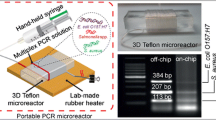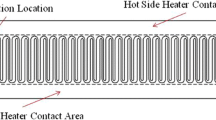Abstract
A microchip for purifying nucleic acids from bacterial pathogens was designed and fabricated in plastic. The fabricated plastic microchips were tested for their ability to purify nucleic acids from the bacteria Listeria monocytogenes (L. monocytogenes), Escherichia coli (E. coli), and Salmonella typhimurium (S. typhimurium). These chips were constructed using rapid and low-cost plastic fabrication techniques including hot embossing and plastic casting. Silicon molds fabricated by photolithography and dry etching were used for chip prototyping. Zeonor plastic (poly (cycloolefin) resin) and epoxy microchips were fabricated using hot embossing and plastic casting, respectively. A low temperature sputtering technique was used to coat a layer of silicon dioxide onto the channel region for nucleic acid binding in chaotropic salt solutions. The purification channels contain an array of features to increase the surface area for DNA binding and purification. DNA was quantified with PicoGreen fluorescent dye and the quality of the material as a substrate for polymerase chain reaction (PCR) was tested using target specific primers. DNA could be recovered from the microchip and detected using PCR from a minimum of 106 of L. monocytogenes, E. coli, and S. typhimurium cells, respectively. With the simplicity of the plastic chip’s fabrication and DNA purification, our microchip makes it ideal for a miniaturized DNA testing system.






Similar content being viewed by others
References
H. Becker, W. Dietz, in SPIE Conference ’98 (Santa Clara, CA, 1998a)
H. Becker, Dietz, in Proceedings of SPIE 3515, (1998b), p. 177
H. Becker, U. Heim, in Proceedings of MEMS’99, (1999), p. 228
H. Becker, U. Heim, Sens. Actuators A 83, 130 (2000)
T.D. Boone, H.H. Hooper, D.S. Soane, in Solid State Sensor and Actuator Workshop ’98 (Hilton Head Island, South Carolina, 1998)
N.C. Cady, S.S., C.A. Batt, Biosens. Bioelectron. 19, 59 (2003)
L.A. Christel, K. Petersen, W. McMillan, M.A. Northrup, J. Biomech. Eng. 121, 22 (1999)
M.B. Esch, S. Kapur, G. Irizarry, V. Genova, Lab. Chip. 3, 121 (2003)
E. Kim, Y. Xia, G.M. Whitesides, Nature 376, 581 (1995)
G.B. Lee, S.H. Chen, G.R. Huang, W.C. Sung, Y.H. Lin, Sens. Actuators B 75, 142 (2001)
L. Lin, C.J. Chiu, W. Bacher, M. Heckele, in Proceedings of the 7th Int. Symp., (1996), p. 67
K.D. Muller, et al., in MME’99: Micromechanics Europe (Gif-sur-Yvette, France, 1999)
O. Roetting, Proc. SPIE 3680, 1038 (1999)
P. Sethu, H. Yu, P. Grodzinski, C.H. Mastrangelo, in Proceedings of Solid-State Sensors and Actuators Workshop (Hilton Head, SC, 2000)
H. Tian, A.F.R. Huhmer, J.P. Landers, Anal. Biochem. 283, 175 (2000)
K.A. Wolfe, M.C. Breadmore, J.P. Ferrance, M.E. Power, J.F. Conroy, P.M. Norris, J.P. Landers, Electrophoresis 23, 727 (2002)
X. Yu, D. Zhang, T. Li, L. Hao, X. Li, Sens. Actuators A 108, 103 (2003)
Y. Zhao, T. Cui, J. Micromechanics and Microengineering 13, 430 (2003)
Acknowledgements
Financial support was provided by the Alliance for Nanomedical Technologies, USDA Grant #03-35201-13691 and FDA Grant #06000002499A. This work was performed in part at the Cornell Nano-Scale Science & Technology Facility (a member of the National Nanofabrication Users Network) which is supported by the National Science Foundation under Grant ECS-9731293, its users, Cornell University and Industrial Affiliates.
Author information
Authors and Affiliations
Corresponding author
Additional information
The research work was done in Cornell University.
Rights and permissions
About this article
Cite this article
Liu, Y., Cady, N.C. & Batt, C.A. A plastic microchip for nucleic acid purification. Biomed Microdevices 9, 769–776 (2007). https://doi.org/10.1007/s10544-007-9088-9
Published:
Issue Date:
DOI: https://doi.org/10.1007/s10544-007-9088-9




